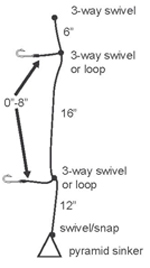
How to fish for surfperch
Surf fishing is one of Oregon’s most underutilized fisheries. There are hundreds of places to fish along Oregon’s sandy beaches, and there are plenty of fish within an easy cast from shore.

The most popular and abundant target for the surf angler is surfperch – slim, saucer-shaped fish that can reach up to 2 pounds. Perhaps their most unusual feature is that the females bear live young that look like miniature versions of the adults. There are nine different species of surfperch found off the Oregon coast, but the most often-caught are redtail surfperch. Schools of surfperch often congregate within 30 feet of the shoreline, darting in and out of the surging surf in search of food, and presenting an accessible target for anglers.
License requirements
A general Oregon Angling License is all that’s required to fish for surfperch.
When and where to fish
Although surfperch are available year-round, the most productive time to fish for them is in the spring and early summer when they school up along sandy shorelines for spawning. The best fishing often occurs on an incoming tide, especially an hour or two before high tide. Take advantage of low tides to scout out good surfperch water. Look for places where there’s a deep hole or depression that could hold surfperch. These places include steeply sloped beaches where the waves break hard, rocky areas in the sand or sandy areas near jetties, or places where the shore cuts inward.
Equipment for surfperch fishing
Rod and reel
Surfperch fishing requires heavy tackle – not to land a 2-pound fish but to handle the heavy surf these fish live in. While there are a lot of personal preferences when it comes to fishing tackle, a good starter outfit for surfperch could include a long (9- to 11-foot) rod capable of handling a 2- to 6- ounce weight, and a spinning reel large enough to hold 200-300 yards of 15- to 30-pound monofilament line. If you’d like to try surfperch fishing before you invest in new tackle, some sporting goods stores on the coast allow you to rent rods and reels by the day.
Terminal tackle
A popular set-up for surfperch includes two #4 or #2 hooks, some swivels and a pyramid sinker. Three-sided pyramid sinkers are common, easy to cast and tend to roll less in the surf. The size of the weight will vary with surf conditions and the size of your rod – use whatever it takes (usually 2 to 6 ounces) to keep your rigging in one spot in the surf. About 12 inches above the sinker attach a 3-way swivel. On one loop tie on the first hook with 6-8 inches of monofilament. You want just enough monofilament to keep your bait away from the mainline. About 16 inches above the first hook attach a second hook in the same way.
Bait
Popular baits for surfperch include mole crabs, marine worms, sand shrimp, mussels and clam necks – the choice depends on availability, convenience and personal preference. Many anglers gather crabs, worms and shrimp during low tide from the same beaches they’re going to fish later. A growing number of surfperch anglers are using plastic baits such as Berkley Gulp sand worms, which are convenient, stay on the hook well and catch fish.
Footwear
Fishing in the surf, it’s guaranteed your feet are going to get wet. If air and water temperatures are comfortable, many anglers simply wear shorts and sandals and get wet. In cooler waters, however, you will be more comfortable in good quality hip boots that keep your feet and legs dry. Chest waders can be comfortable if it’s cold and rainy, but aren’t usually necessary.
Other surfperch opportunities
Many kinds of surfperch are also found in bays, estuaries and along rocky ocean shorelines. Look for water with some kind of structure (rocks, jetties, pilings, sunken ships, etc.) and keep your line and bait close to that structure.
A final note on keeping fish
The bag limit for surfperch is generous – 15 in aggregate per day. However, a lot remains unknown about the size of surfperch populations off the Oregon Coast. Certainly keep enough for a dinner or two (they are excellent eating), but don’t hesitate to catch and then carefully release surfperch to help safeguard future populations.
Header photo by Kathy Munsel


